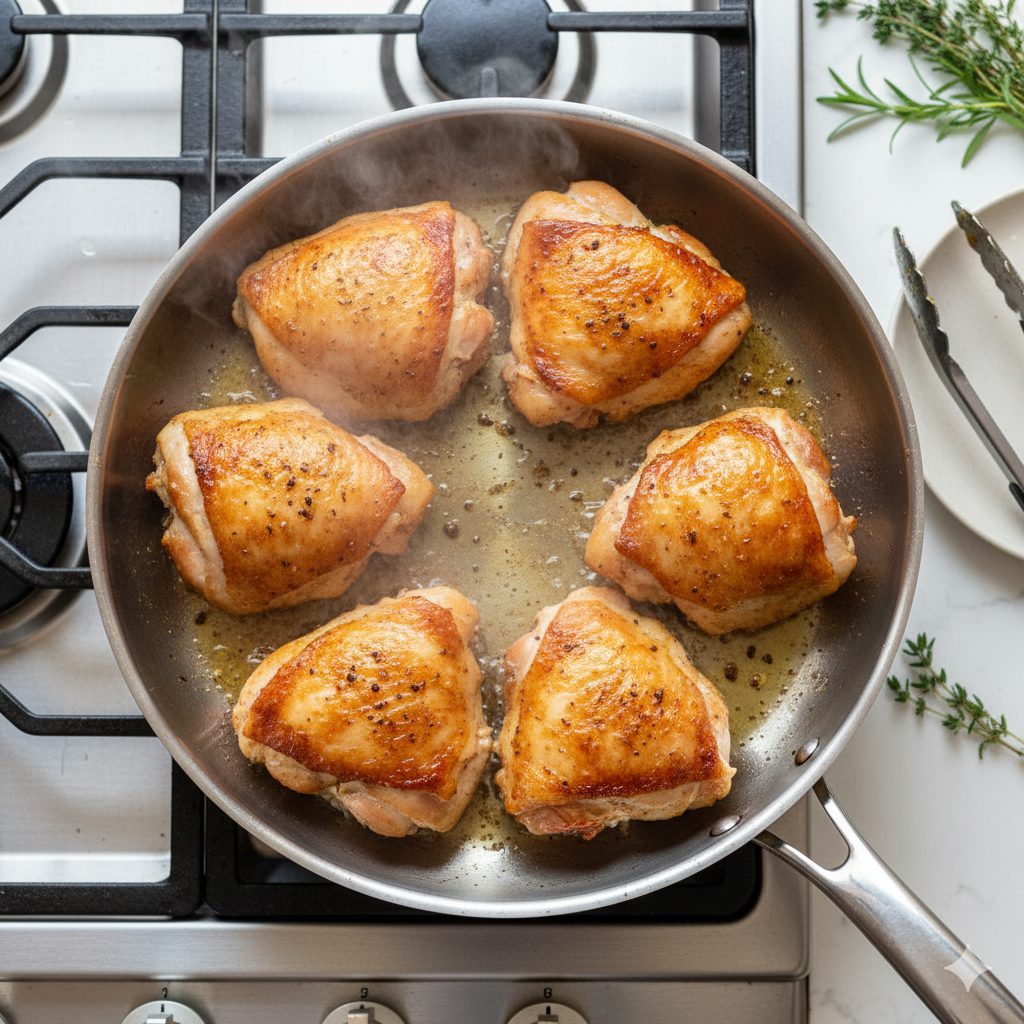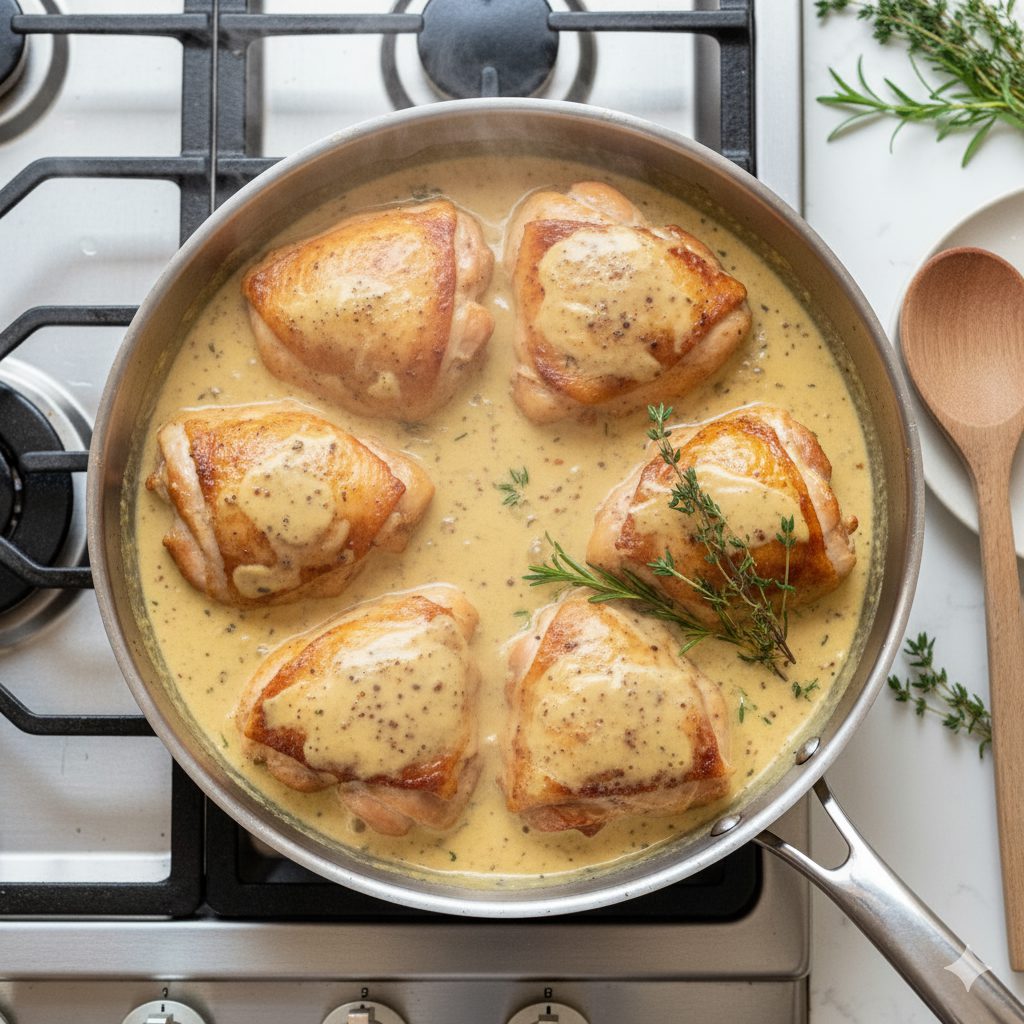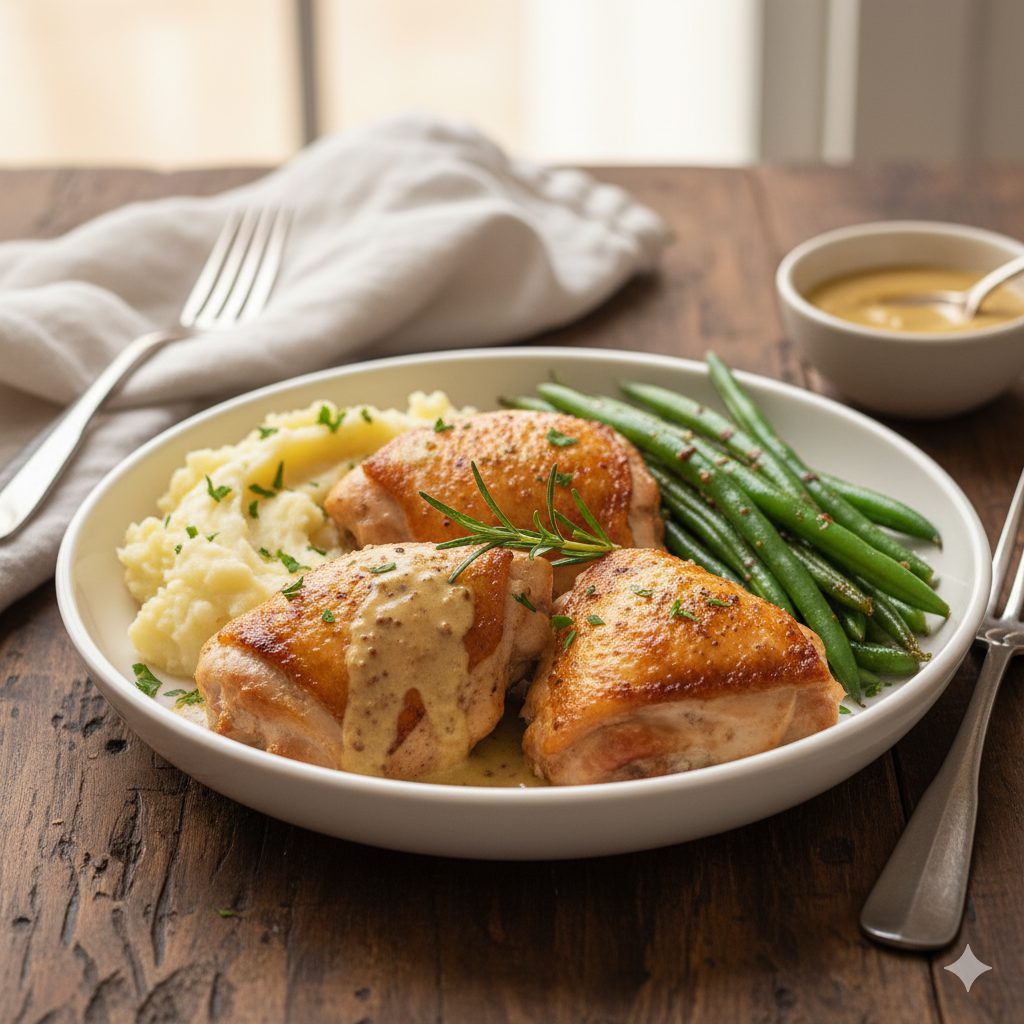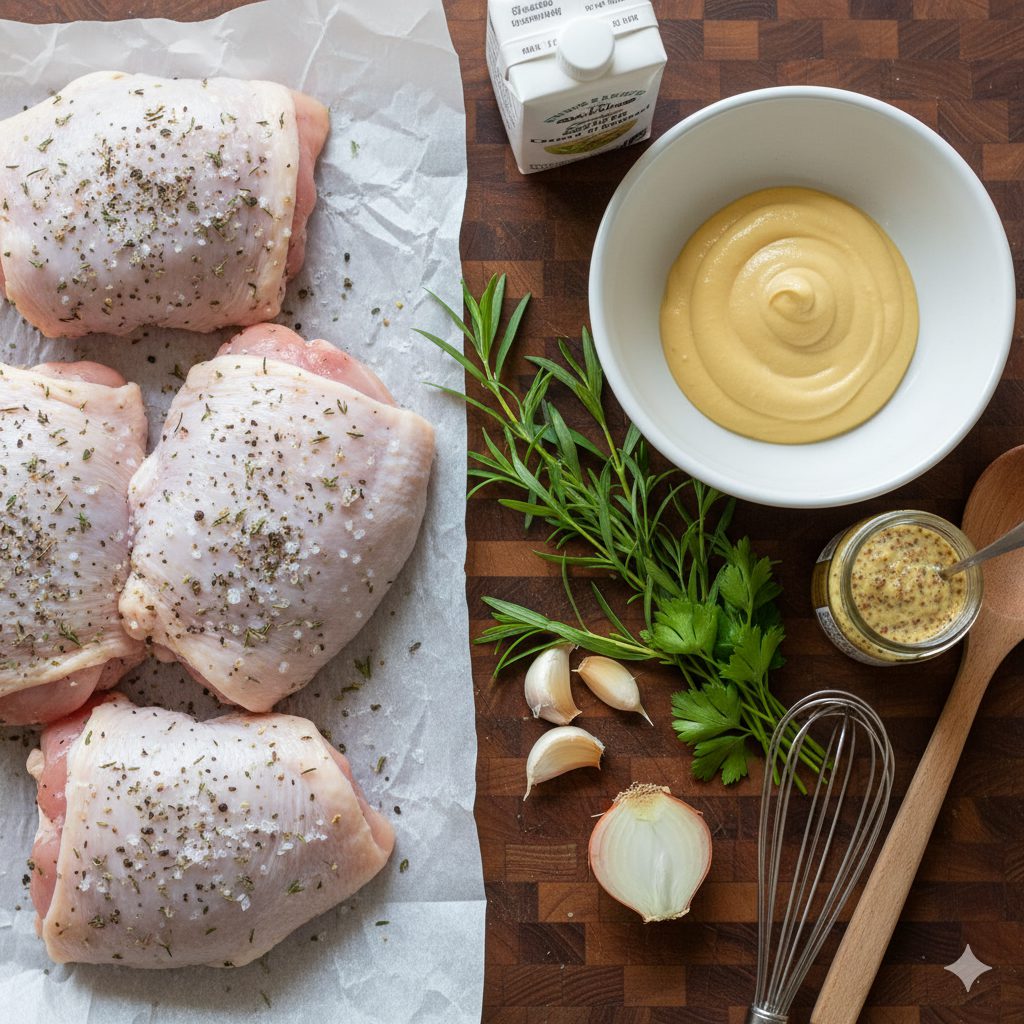Braise the Chicken:

Introduce the chicken broth, thyme branches, and bay leaf to the reduced wine mixture. Bring the liquid to a gentle, rolling heat. Carefully put the chicken pieces back into the liquid, ensuring the crisp skin remains facing upwards. Cover the pot and slow-cook (braise) the ensemble for 20 minutes; the meat should achieve a wonderful fork-tender state.
5 Refine the Sauce:

Lift the chicken out of the pot and maintain its warmth under a cover. Remove and discard the thyme and bay leaf. Now, whisk in the heavy cream, the Dijon, and the whole-grain mustard until the sauce is smooth and completely combined. Allow the mixture to reduce slightly and thicken. Once complete, sample the sauce and make any necessary corrections to the salt or pepper.
6 Unify and Present:

Place the perfectly cooked chicken back into the skillet. Spoon a portion of the thickened mustard sauce over each piece. Give it a minute on low heat to ensure everything is warm. Plate the chicken, ladle the remaining sauce over it, and sprinkle with chopped parsley before serving.
Servings 4
- Amount Per Serving
- % Daily Value *
- Total Fat 47g73%
- Saturated Fat 14g70%
- Cholesterol 209mg70%
- Sodium 1268mg53%
- Total Carbohydrate 7g3%
- Dietary Fiber 2g8%
- Sugars 2g
- Protein 38g76%
* Percent Daily Values are based on a 2,000 calorie diet. Your daily value may be higher or lower depending on your calorie needs.
Note
Mastering the Technique: Essential Tips
The secret to an exceptional Poulet à la Moutarde lies in the interplay between browning, deglazing, and balancing the rich sauce.
- The Power of the Pan: Always use an oven-safe, heavy-bottomed skillet or a Dutch oven. The heavier material (like cast iron) retains heat better and distributes it evenly, which is crucial for a consistent sear. Avoid non-stick pans, as they prevent the formation of the fond—the browned, flavorful bits stuck to the bottom of the pan—which is the absolute foundation of the sauce's depth.
- A Proper Sear is Non-Negotiable: When browning the chicken (preferably skin-on, bone-in thighs or drumsticks for maximum flavor and moisture), do not overcrowd the pan. Cook the pieces in batches if necessary, ensuring each piece has enough space to make direct contact with the hot surface. This high-heat sear develops a beautiful golden-brown crust and renders fat, which adds another layer of flavor.
- The Crucial Deglaze: After removing the seared chicken, add your dry white wine (something you'd actually drink, like a Sauvignon Blanc). Use a wooden spoon to aggressively scrape up all the fond from the pan's base. This step dissolves those concentrated flavor bits into the liquid, transforming them into the heart of your rich sauce.
- Mustard Management: For the best results, use two types of mustard. Use a smooth, creamy Dijon mustard for the primary rub and body of the sauce, and incorporate a bit of whole-grain mustard at the very end. The whole-grain mustard adds a delightful texture and a pop of sharper, pungent flavor right before serving, preventing its seeds from over-softening during the braise.
- The Finishing Touch: The sauce is traditionally finished with a dairy element to mellow the acidity and add luxurious texture. Use crème fraîche for the most authentic, velvety result. Alternatively, heavy cream or a mixture of heavy cream and a dollop of sour cream will also work beautifully, but add it after the braising is complete to prevent curdling.
Serving Tricks and Accompaniments
The intense, savory, and tangy nature of French Mustard Chicken sauce demands simple, complementary side dishes that can effectively soak up the liquid gold.
- Starch Soakers: The best companion is something simple that provides a canvas for the sauce. Consider:
- Mashed Potatoes: Their soft texture and mild flavor are ideal for cradling the sauce.
- Crusty Bread (Baguette): Essential for the classic French sauce-mopping experience, known as faire chabrot.
- Fluffy White Rice: A great neutral option to absorb the savory juices.
- Vegetable Balance: Pair the rich chicken with something fresh and slightly bitter or acidic to cleanse the palate.
- Steamed Haricots Verts (French Green Beans): Served plain or lightly sautéed with butter and slivered almonds.
- Asparagus: Lightly roasted or steamed.
Exciting Variations and Adaptations
While the traditional recipe is flawless, there are several ways to adapt it to dietary needs or flavor preferences.
- Protein Swap: This sauce base works wonderfully with other proteins. Try it with pork tenderloin medallions or firm white fish filets (like cod or halibut), adjusting the cooking time significantly downward for fish. For a lighter version, use boneless, skinless chicken breasts, but be mindful that they braise quickly; check the internal temperature frequently to avoid drying them out.
- Aromatic Twists:
- Herbal Focus: While thyme is traditional, experiment by adding tarragon for a delicate anise note, or a pinch of Herbes de Provence for a more complex, sun-drenched flavor profile.
- Mushroom Inclusion: Sauté sliced cremini or wild mushrooms in the pan after the chicken is removed, before deglazing with wine. They soak up the cooking fat and add a fantastic earthy dimension to the final sauce.
- Spice Kick: Introduce a tiny pinch of smoked paprika or a dash of cayenne pepper to the mustard rub for a subtle background warmth that complements the tanginess.
- Dairy-Free Modification: For those avoiding heavy cream, you can achieve a similar creamy, velvety texture using full-fat coconut milk or cream, though this will introduce a subtle sweetness. Alternatively, a cornstarch slurry mixed with the chicken stock and simmered can provide thickness without the dairy richness.
Storage and Reheating Strategy
- The Cream Consideration: The only caution comes from the cream. Cream-based sauces can sometimes "break" or separate when reheated rapidly or at too high a temperature.
- Reheating Method: Stir constantly and add a small splash of chicken stock or water if the sauce appears too thick or starts to separate. Avoid using a microwave on high power.
- Freezing is Not Recommended: Due to the cream content, the sauce is likely to separate into an unpleasant, granular texture upon thawing.
Conclusion
French Mustard Chicken (Poulet à la Moutarde) is far more than a simple weeknight meal; it is a testament to the fact that minimal, high-quality ingredients, when treated with respect and technique, can yield a truly remarkable culinary experience. By focusing on a perfect sear, diligent deglazing, and the use of authentic Dijon mustard and crème fraîche, you transform humble chicken into an elegant, comforting dish that is a staple of French home cooking. This recipe is a must-make for anyone seeking a sophisticated dinner that remains fundamentally easy to execute.
Keywords:
Poulet à la Moutarde, Dual-Mustard Sauce, Braised Chicken, Dijon & Whole-Grain, One-Pan French,
Did you make this recipe?
Pin this recipe to share with your friends and followers.


 Generously apply salt and pepper to all surfaces of the chicken pieces. Heat the olive oil and butter in a heavy-bottomed pan or Dutch oven over medium-high heat. Place the chicken in the hot pan, skin-side facing down, and allow it to develop a deep, crisp, golden-brown crust for 5–7 minutes. Turn the pieces briefly to sear the reverse side, then take them out of the pan and temporarily set the chicken aside on a clean platter.
Generously apply salt and pepper to all surfaces of the chicken pieces. Heat the olive oil and butter in a heavy-bottomed pan or Dutch oven over medium-high heat. Place the chicken in the hot pan, skin-side facing down, and allow it to develop a deep, crisp, golden-brown crust for 5–7 minutes. Turn the pieces briefly to sear the reverse side, then take them out of the pan and temporarily set the chicken aside on a clean platter. Introduce the chicken broth, thyme branches, and bay leaf to the reduced wine mixture. Bring the liquid to a gentle, rolling heat. Carefully put the chicken pieces back into the liquid, ensuring the crisp skin remains facing upwards. Cover the pot and slow-cook (braise) the ensemble for 20 minutes; the meat should achieve a wonderful fork-tender state.
Introduce the chicken broth, thyme branches, and bay leaf to the reduced wine mixture. Bring the liquid to a gentle, rolling heat. Carefully put the chicken pieces back into the liquid, ensuring the crisp skin remains facing upwards. Cover the pot and slow-cook (braise) the ensemble for 20 minutes; the meat should achieve a wonderful fork-tender state. Lift the chicken out of the pot and maintain its warmth under a cover. Remove and discard the thyme and bay leaf. Now, whisk in the heavy cream, the Dijon, and the whole-grain mustard until the sauce is smooth and completely combined. Allow the mixture to reduce slightly and thicken. Once complete, sample the sauce and make any necessary corrections to the salt or pepper.
Lift the chicken out of the pot and maintain its warmth under a cover. Remove and discard the thyme and bay leaf. Now, whisk in the heavy cream, the Dijon, and the whole-grain mustard until the sauce is smooth and completely combined. Allow the mixture to reduce slightly and thicken. Once complete, sample the sauce and make any necessary corrections to the salt or pepper. Place the perfectly cooked chicken back into the skillet. Spoon a portion of the thickened mustard sauce over each piece. Give it a minute on low heat to ensure everything is warm. Plate the chicken, ladle the remaining sauce over it, and sprinkle with chopped parsley before serving.
Place the perfectly cooked chicken back into the skillet. Spoon a portion of the thickened mustard sauce over each piece. Give it a minute on low heat to ensure everything is warm. Plate the chicken, ladle the remaining sauce over it, and sprinkle with chopped parsley before serving.

